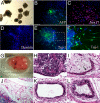Feeder-free derivation of induced pluripotent stem cells from adult human adipose stem cells
- PMID: 19805220
- PMCID: PMC2739869
- DOI: 10.1073/pnas.0908450106
Feeder-free derivation of induced pluripotent stem cells from adult human adipose stem cells
Abstract
Ectopic expression of transcription factors can reprogram somatic cells to a pluripotent state. However, most of the studies used skin fibroblasts as the starting population for reprogramming, which usually take weeks for expansion from a single biopsy. We show here that induced pluripotent stem (iPS) cells can be generated from adult human adipose stem cells (hASCs) freshly isolated from patients. Furthermore, iPS cells can be readily derived from adult hASCs in a feeder-free condition, thereby eliminating potential variability caused by using feeder cells. hASCs can be safely and readily isolated from adult humans in large quantities without extended time for expansion, are easy to maintain in culture, and therefore represent an ideal autologous source of cells for generating individual-specific iPS cells.
Figures




References
-
- Takahashi K, et al. Induction of pluripotent stem cells from adult human fibroblasts by defined factors. Cell. 2007;131:861–872. - PubMed
-
- Park IH, et al. Reprogramming of human somatic cells to pluripotency with defined factors. Nature. 2008;451:141–146. - PubMed
-
- Yu J, et al. Induced pluripotent stem cell lines derived from human somatic cells. Science. 2007;318:1917–1920. - PubMed
Publication types
MeSH terms
Substances
Grants and funding
LinkOut - more resources
Full Text Sources
Other Literature Sources
Molecular Biology Databases
Research Materials

